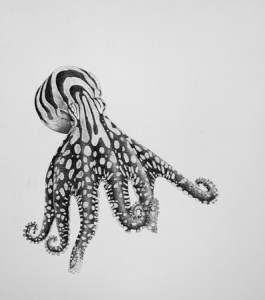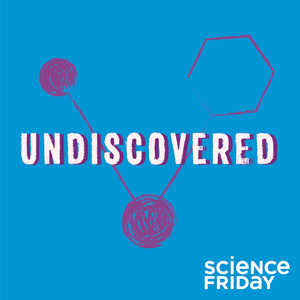
Universe of Art
Science Friday & WNYC Studios
Meet artists who use science to bring their creations to the next level.
- 17 minutes 47 secondsHow insects changed the world—and human culture
Did you know that there are ten quintillion—or 10,000,000,000,000,000,000—individual insects on the planet? That means that for each and every one of us humans, there are 1.25 billion insects hopping, buzzing, and flying about.
A new book called The Insect Epiphany: How Our Six-Legged Allies Shape Human Culture celebrates the diversity of the insect world, as well as the many ways it has changed ours—from fashion to food to engineering.
Guest host Sophie Bushwick talks with entomologist and author Dr. Barrett Klein about the beauty of the insect world, how it has shaped human history, and what we can learn from these six-legged critters.
Further Reading
- Check out Dr. Barrett Klein's artwork on his website.
- Watch a Ted talk about imagining a world without insects.
12 November 2024, 11:00 am - 13 minutes 31 secondsIntertwining the lives of moths and humans through music
Before the pandemic, Peter Kiesewalter didn’t think much of moths. Like a lot of people, he’d thought of them mostly as pests. But when his brother Tobi, an interpretive naturalist for Ontario Parks and moth enthusiast, showed him macro photos he’d taken of them, he was blown away. “[They were] absolutely stunning,” Peter says. “The amount of colors and hair were just extraordinary.”
Peter is a Grammy-nominated musician based in New York City. He’s composed music for ABC News, Monday Night Football, and even a “Winnie The Pooh” show. As COVID-19 spread in 2020, work for him and his partner Whitney La Grange, a professional violinist, dried up. So they hunkered down at the family cottage in Ottawa, Canada, along with Tobi’s family. Peter was looking for a new show idea, and when his brother opened up the world of moths to him, he was hooked. “I had to find a way to interpret moths artistically,” he said. “And I started to find connections between them and us.”
That led to “The Moth Project,” a concept album and stage show that combines moth science and visuals with a whole ecosystem of musical genres: 80s pop, funk, classical, covers, even spoken word. Each song ties a stage of a moth’s life (emergence, flight, migration) to a universal human experience. But for Peter, a lot of these songs turned out to be far more personal than he initially thought.
SciFri producer and host of our Universe of Art podcast D Peterschmidt sat down with Peter and Tobi Kiesewalter and Whitney La Grange to find out how this album came together and how understanding moths could better help us understand ourselves.
If you want to see “The Moth Project” live, you can find out about upcoming shows here.
Universe of Art is hosted and produced by D Peterschmidt, who also wrote the music. Our show art is illustrated by Abelle Hayford. And support for Science Friday's science and arts coverage comes from the Alfred P. Sloan Foundation.
Do you have science-inspired art you’d like to share with us for a future episode? Send us an email or a voice memo to [email protected].
29 October 2024, 10:00 am - 11 minutes 31 secondsBenjamin Franklin and the American experiment collide on stage
When you think of famous scientists of the early United States, you likely think of Benjamin Franklin, inventor of the lightning rod, bifocal glasses, and even the glass harmonica.
He and his son are the subject of the play “Franklinland.” It explores their sometimes contentious relationship, Benjamin Franklin’s accomplishments as a scientist, and how the scientific method can be used to understand the ongoing experiment of the United States. It’s running now until November 3 at the Ensemble Studio Theater in New York City.
Ira Flatow is joined by the playwright of “Franklinland,” Lloyd Suh, to learn how he joined all of these elements for the stage.
Universe of Art is hosted and produced by D Peterschmidt, who also wrote the music. Our show art is illustrated by Abelle Hayford. And support for Science Friday's science and arts coverage comes from the Alfred P. Sloan Foundation.
Do you have science-inspired art you’d like to share with us for a future episode? Send us an email or a voice memo to [email protected].
15 October 2024, 10:00 am - 19 minutes 23 secondsPollution cookies and the hidden physics in Van Gogh's 'Starry Night'
Would you be interested in a cookie infused with smog from your favorite city? Maybe a loaf of sourdough made from wheat tainted by wildfires?
Those are just a few of the projects from the Center for Genomic Gastronomy, based in Amsterdam and Portugal, where artists use innovative ingredients to represent environmental crises and imagine what the future of food could look like.
Ira talks with Zack Denfeld, co-founder of the Center for Genomic Gastronomy, about how art and food can help us envision a more sustainable food system.
Read the full story about how artists and chefs are putting ecological crises on the menu.
Plus, one of Vincent Van Gogh’s most famous creations is “The Starry Night,” an oil painting of a quaint French village at night with a blue night sky that dramatically swirls around the yellow stars and moon.
It’s easy to admire this painting as a casual viewer, but if you research fluid dynamics, one thing in particular stands out: those iconic swirls in the sky. To a physicist, they look an awful lot like the swirls that atmospheric turbulence produces. And some researchers have been wondering if Van Gogh’s swirls actually match the mathematical models of turbulence theory.
Well, a team of researchers from China and France set out to analyze all the swirls in “The Starry Night,” and it turns out that Van Gogh had a knack for depicting the forces of nature. Their results were published in the journal Physics Of Fluid.
Guest host Anna Rothschild sits down with Dr. Francois Schmitt, research professor in physics at the French National Centre for Scientific Research and co-author of the recent study, to talk about the hidden physics in this famous painting.
Universe of Art is hosted and produced by D Peterschmidt, who also wrote the music. The first segment was produced by Rasha Aridi and Robin Kazimer, and the last segment was produced by D Peterschmidt. Our show art is illustrated by Abelle Hayford. And support for Science Friday's science and arts coverage comes from the Alfred P. Sloan Foundation.
Do you have science-inspired art you’d like to share with us for a future episode? Send us an email or a voice memo to [email protected].
1 October 2024, 10:00 am - 11 minutes 34 secondsHow a diver and artist brought a mysterious octopus to light
Octopus mating behaviors can be quite deadly. Many species are cannibalistic, making the entire prospect of mating dangerous, and female octopuses often die after laying one clutch of eggs. Their cannibalistic tendencies mean that octopuses don’t socialize as much as other animals.
But the larger Pacific striped octopus (LPSO) is different. For one, they live together in colonies. And mating is not only a safer proposition, it involves beak-to-beak “kissing.” Plus, females can lay eggs repeatedly, even tending to embryos at various stages of development.
But because these behaviors are so uncharacteristic of most octopuses, the scientific community didn’t officially recognize their existence until 2015, despite the decades-long effort of a Panamanian diver and artist named Arcadio Rodaniche. When he tried to share his findings about the LPSO at a symposium and publish them in a journal, he was flatly rejected. But his persistent research and documentation of the species would eventually be validated when researchers were able to obtain and observe the octopuses in captivity.
SciFri producer Kathleen Davis sits down with freelance science writer Kenna Hughes-Castleberry to talk about an article she reported for Science Friday about the late Rodaniche and his yearslong effort to get official scientific recognition for the LPSO.

An illustration of a larger Pacific striped octopus by Arcadio Rodaniche. Image courtesy of Denice Rodaniche.
Universe of Art is hosted and produced by D Peterschmidt, who also wrote the music and produced the original segment, along with Val Diaz. Our show art is illustrated by Abelle Hayford. And support for Science Friday's science and arts coverage comes from the Alfred P. Sloan Foundation.
Do you have science-inspired art you’d like to share with us for a future episode? Send us an email or a voice memo to [email protected].
17 September 2024, 10:00 am - 12 minutes 33 secondsWhat newly discovered cave art tells us about human creativity
In July, researchers discovered the oldest known cave art. It was found in a cave on the Indonesian island of Sulawesi, and it shows three human-like figures and a wild pig. The painting was dated at 51,200 years old—5,000 years older than any other known cave art.
The finding continues a trend of researchers unearthing older and older examples of human-made art, including those found outside of Spain and Southern France, where most cave art discoveries have been made.
Guest host Maggie Koerth is joined by Dr. Isobel Wisher, a postdoctoral researcher with the Evolution of Early Symbolic Behavior project at Aarhus University in Denmark, to discuss how this field of archeology has changed over the years, how new technology is making these ancient cave paintings more accessible to the public, and what they can tell us about the human experience.
Universe of Art is hosted and produced by D. Peterschmidt, who also wrote the music and produced the original segment. Our show art is illustrated by Abelle Hayford. And support for Science Friday's science and arts coverage comes from the Alfred P. Sloan Foundation.
Do you have science-inspired art you’d like to share with us for a future episode? Send us an email or a voice memo to [email protected].
3 September 2024, 10:00 am - 18 minutes 4 secondsHow ancient art influenced modern astronomy
Looking into space can be pretty daunting. How do we make sense of the vast expanse above our heads, the millions of stars we might be able to see, and the billions more we can’t?
Now, what about listening to space? That’s the task that Sam Harnett and Chris Hoff gave themselves, for their series “Cosmic Visions.” They’re the team behind “The World According to Sound,” a podcast that’s brought our listeners close to the sounds of science over the last few years.
This new series takes listeners through the history of astronomy and the study of the cosmos, from ancient Babylon to the Hubble Telescope. Harnett and Hoff join guest host John Dankosky to talk about why different ways of knowing are helpful for scientists, how images of nebulae share a striking resemblance to photos of the American West, and what their favorite space sounds are.
Universe of Art is hosted and produced by D. Peterschmidt, who also wrote the music and produced the original segment. Our show art is illustrated by Abelle Hayford. And support for Science Friday's science and arts coverage comes from the Alfred P. Sloan Foundation.
Do you have science-inspired art you’d like to share with us for a future episode? Send us an email or a voice memo to [email protected].
20 August 2024, 10:00 am - 18 minutes 18 secondsHow science fiction influenced American psychological warfare
When you think about connections between science and war, the obvious links are in technology—advanced radar, spy satellites, more powerful explosives—and in medical innovations that seek to heal the wounds caused by conflict. But in a new book, Stories are Weapons: Psychological Warfare and the American Mind, author Annalee Newitz says that stories and narrative can be weapons too, used in battle on a psychological battlefield.
Ira talks with Newitz about the history of psychological warfare, from Sun Tzu to Benjamin Franklin, and its modern American incarnation under the guidance of Paul Linebarger, who was also a science fiction author known by the pen name Cordwainer Smith. They discuss the characteristics of a psyop, how techniques of psychological warfare have been co-opted into modern politics, and whether there’s a route toward “psychological disarmament.”
Read an excerpt from Stories are Weapons: Psychological Warfare and the American Mind.
Universe of Art is hosted and produced by D. Peterschmidt, who also wrote the music. The original segment was produced by Charles Bergquist. Our show art is illustrated by Abelle Hayford. And support for Science Friday's science and arts coverage comes from the Alfred P. Sloan Foundation.
Do you have science-inspired art you’d like to share with us for a future episode? Send us an email or a voice memo to [email protected].
6 August 2024, 10:00 am - 18 minutes 16 secondsThe tornado science of 'Twisters' and a real-life 'Dune' stillsuit
“Twisters,” the long awaited follow-up to the 1996 movie “Twister” is out now. It’s about a scientist (Daisy Edgar-Jones) who goes back to her home state of Oklahoma to try and stop a massive tornado outbreak from wreaking havoc on its citizens. On the way, she meets a quirky cast of storm chasers, and butts heads with a band of unorthodox “tornado wranglers” led by a YouTube personality (Glen Powell). “Twisters” delights in name-dropping tornado jargon, and its science advisory team said they hoped to make the movie as accurate as possible.
The movie makes science thrilling, but it also shows the ways that tornadoes affect people’s lives in the real world. For example, earlier this week, the Chicago area was hit with multiple tornadoes during a night of extreme weather, leaving thousands without power, and four tornadoes hit upstate New York, killing one person. This comes after a powerful, and some say unusual, tornado season in the Midwest. But just how tornadoes will continue to change is still unknown.
Digital producer Emma Gometz talks with Dr. Bill Gallus, a meteorology professor at Iowa State University, to decode some of the science from “Twisters” and understand how real-life tornadoes are changing.
Plus, on the International Space Station, resources are precious. That includes every single drop of water—which is why astronauts drink their own filtered and recycled pee. That might sound a little undignified, but things get worse when astronauts go out for a space walk. If nature comes calling, their only option is a super-strength diaper.
Inspired by the stillsuits that recycle water in Frank Herbert’s ‘Dune’ series, researchers have come up with a way to keep astronauts clean, dry, and hydrated while they’re hard at work. They’ve designed a system that turns astronauts’ pee into nice, clean drinking water while they’re suited up.
The researchers reported on their prototype in the journal Frontiers in Space Technology. Guest host Rachel Feltman talks with Sofia Etlin, a researcher at Weill Cornell Medicine, about the inspiration behind the stillsuit and how it works.
Universe of Art is hosted and produced by D. Peterschmidt, who also wrote the music. Those original segments were produced by Emma Gometz and Rasha Aridi. Our show art is illustrated by Abelle Hayford. And support for Science Friday's science and arts coverage comes from the Alfred P. Sloan Foundation.
Do you have science-inspired art you’d like to share with us for a future episode? Send us an email or a voice memo to [email protected].
23 July 2024, 10:00 am - 30 minutes 4 secondsThe best summer science beach reads for 2024
It’s officially summertime, and the season of reading is finally here! Two science writers and voracious readers have compiled their summer reading recommendations, just for Science Friday fans. Before you head out for a week at the beach, start packing for that road trip, or stock up for a long staycation, we’ve got the list of science-y summer reads, straight from those familiar with the best on the shelf.
Joining guest host Diana Plasker to offer listeners their recommendations are Riley Black, a Salt Lake City-based science writer and the author of several books, including The Last Days of the Dinosaurs: An Asteroid, Extinction, and the Beginning of Our World; and Deborah Blum, director of the Knight Science Journalism program at the Massachusetts Institute of Technology and author of several books, including The Poison Squad: One Chemist’s Single-Minded Crusade for Food Safety at the Turn of the Twentieth Century, based in Cambridge, Massachusetts.
You can check out the full list here.
Universe of Art is hosted and produced by D. Peterschmidt, who also wrote the music. Our show art was illustrated by Abelle Hayford. Support for Science Friday’s science and arts coverage comes from the Alfred P. Sloan Foundation.
Do you have science-inspired art you’d like to share with us for a future episode? Send us an email or a voice memo to [email protected].
9 July 2024, 10:00 am - 17 minutes 38 secondsMeet the emotions behind teenage angst in ‘Inside Out 2’
In the 2015 film “Inside Out,” audiences met 11-year-old Riley and her team of emotions: Joy, Sadness, Fear, Disgust, and Anger, each represented by a different character. They lived inside Riley’s mind to help guide her feelings and actions, and towards the end of the film, their emotional control center gets an upgrade with a puberty button.
That’s where the new film “Inside Out 2” picks up. Riley is now 13 years old and dealing with the slew of emotions that come with puberty. In the new film, moviegoers meet a new crew of characters: Anxiety, Envy, Embarrassment, and Ennui, who is always bored.
But what’s the science behind Riley’s newfound teenage angst? Guest host Annie Minoff talks with psychologist Dr. Lisa Damour, who served as a science advisor to the film.
Universe of Art is hosted and produced by D. Peterschmidt, who also wrote the music. The original segment was produced by Rasha Aridi. Our show art was illustrated by Abelle Hayford. Support for Science Friday’s science and arts coverage comes from the Alfred P. Sloan Foundation.
Do you have science-inspired art you’d like to share with us for a future episode? Send us an email or a voice memo to [email protected].
25 June 2024, 10:00 am - More Episodes? Get the App
Your feedback is valuable to us. Should you encounter any bugs, glitches, lack of functionality or other problems, please email us on [email protected] or join Moon.FM Telegram Group where you can talk directly to the dev team who are happy to answer any queries.
 The New Yorker Radio Hour
The New Yorker Radio Hour
 On Point | Podcast
On Point | Podcast
 Undiscovered
Undiscovered
 Radiolab
Radiolab
 Fresh Air
Fresh Air
 Science Friday
Science Friday